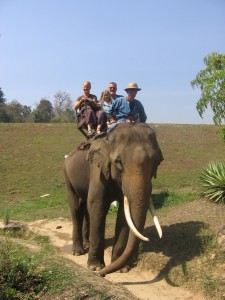Whether traveling independently or on a tour, an elephant encounter is almost certainly a part of a trip to Thailand. Modern Thais recognize our western fascination with the massive pachyderms and camps, shows, and trekking have proliferated with the advance of tourism. But the historical role of elephants in Thai society has been much more than entertainment for tourists. Elephants have long been an important element of Thai spiritual, cultural, and economic life.

As a significant presence in both Hindu and Buddhist mythology elephants hold a place of profound spiritual significance. The Hindu deity Ganesh, with his elephant’s head, is the god of knowledge and remover of obstacles and is depicted on temples throughout the country. Another Hindu deity, Indra is often shown with his three-headed elephant mount Erawan. In Buddhist lore the future Buddha’s mother was only able to conceive after dreaming of a white elephant. The legend is the source of the elephant’s sacred/royal status in Thailand. Throughout Thai history rare white elephants were considered sacred and, by law, belonged only to the king. The 13th century King Ramkhamhaeng of Sukhothai furthered the special status by adopting the white elephant as a symbol of greatness and divinity. The current Thai king owns twelve.
Official white elephant status is conferred only after passing a battery of rigorous physical and behavioral tests. A successful candidate is presented to the king in an elaborate ceremony which includes a parade and anointing with holy water. Our expression “white elephant” probably has its origins in the legend that Thai kings once presented enemies with actual white elephants. Elephants were and are expensive to maintain. Since white elephants were sacred they could not be used for labor, thus making an undue burden for those having received them.
Beyond their symbolic role Thai elephants have long provided a practical benefit. Elephants were valuable resources for warfare, providing formidable physical and psychological advantages. Nineteenth century king Rama IV (of “The King and I” fame) really did offer Abraham Lincoln elephants to use in the Civil War. Elephants have also been tremendous beasts of burden, helping to move massive stones, clear forests, and carry timber. Domesticated elephants are assigned their own mahout (trainer, keeper, and driver). Training begins at age 4 and progresses very gradually, slowly building trust, over a dozen years. In that time the elephant learns about 40 commands. At age 16 the elephant is ready to labor for the next 35 to 45 years.
Recent events have made the plight of Thailand’s elephants precarious. Ironically, the timber industry has proved to be a negative factor. Mechanized logging has rapidly destroyed elephant habitat and overuse has led to a commercial logging ban in 1989. The wild elephant population has been reduced to under 2000 while the domestic population, around 3000 (from a total population of 15,000 in 1984), has been made largely redundant. Unemployment has forced many mahouts to turn their animals loose. The freed beasts become nuisances and are frequently hunted and killed. Ecotourism appears to be one of the only sustainable sources of elephant employment remaining in Thailand.
As part of our commitment to responsible travel, Imprint Tours’ Tantalizing Thailand visits the Thai Elephant Conservation Center near Lampang. Originally established as Thailand’s first elephant training center, the ECC has emphasized elephant conservation since opening their current center in 1992. Entrance proceeds help finance the elephant hospital which cares for sick, abused, and abandoned elephants. We arrive to see the elephants bathing in the river, then enjoy the elephant show (transporting logs, demonstrating skills, painting, and even making music), and enjoy a jungle ride. The ECC also offers a unique home-stay program where participants spend up to three days learning to be temporary mahouts. www.changthai.com
We arrive to see the elephants bathing in the river, then enjoy the elephant show (transporting logs, demonstrating skills, painting, and even making music), and enjoy a jungle ride. The ECC also offers a unique home-stay program where participants spend up to three days learning to be temporary mahouts. www.changthai.com
